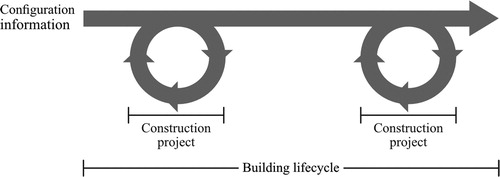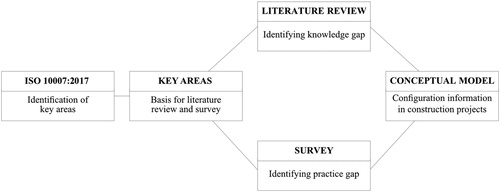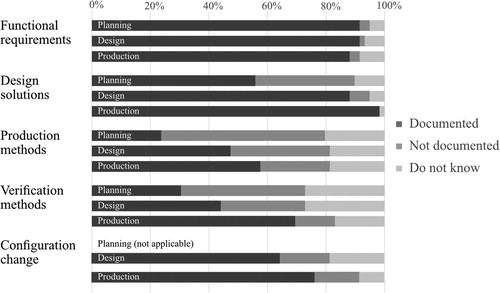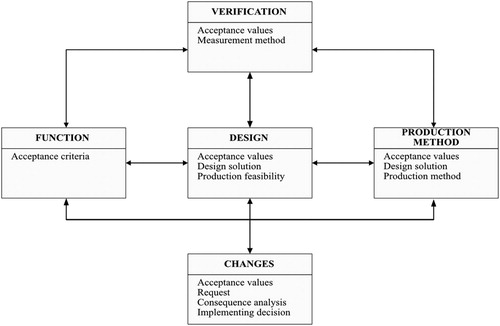ABSTRACT
The architecture, engineering and construction industry focus on the project rather than on the product management. However, the development of digital and automated techniques requires more product based processes. Configuration information is an essential part of product management to ensure high performance. This study aims to explore if systematic configuration information, used in product development, can be applied in construction projects. An international guideline and an extensive literature study identified five key areas of configuration information applicable to construction projects. This knowledge was synthesised into a conceptual model for managing configuration information. A survey investigated the application of configuration information in construction projects. In comparison with the model, the results from the literature review and the survey show that configuration information was insufficient and not managed systematically. However, the findings also indicate that systematic configuration information can be used to improve control over the product and solve several problems encountered by construction projects. This study fills a knowledge gap regarding the management of configuration information in the context of construction projects. The ongoing development of new technologies in the architecture, engineering and construction industry will make the subject of configuration information increasingly important.
Introduction
Processes that define and maintain the configuration throughout a project can ensure delivery of a product with the intended performance. Industries involved in product development often practice configuration management (Zhang Citation2014). An important part of this management is the configuration information, which includes function, design, realisation, audits and change control (ISO Citation2017). The architecture, engineering and construction (AEC) industry is often focused on processes associated with project management (Shen et al. Citation2010). The shifts towards digital building information and automated production techniques in the AEC industry requires processes similar to those used in product development industries (Bock Citation2015). Traceable and available information about the configuration will be an essential part of managing the product from planning to delivery in construction projects (Froese Citation2010).
Through a building lifecycle, accurate configuration information ensures that the property owner's intentions regarding performance are fulfilled (Pärn, Edwards, and Sing Citation2017). Even after the demolition of a building, the configuration information can continue to add knowledge to future designs and construction projects (Eleftheriadis, Duffour, and Mumovic Citation2018). Reliable information about the configuration (as built) flows from property owners to construction projects and back, as shown in . Increased focus on optimising product configurations can prolong the lifecycle of buildings and consequently reduce the environmental impact of the AEC industry (UNEP Citation2018). There are general performance requirements on buildings, such as standards for constructions and sustainability. Healthcare facilities have additional requirements to ensure end-user functionality for diagnosis, treatment and care for patients, which makes the construction technically complex and the end-product does not always fulfil the intended performance (Van Hoof et al. Citation2015).
Configuration management is not extensively practiced the AEC industry, but has been applied by other industries for at least two to three decades (Zhang Citation2014). The present study aims to fill this gap by proposing a model for managing configuration information in construction projects. The availability of information in accordance with the proposed model was studied in healthcare construction projects through a survey addressed to project managers.
Background
Configuration management aims to describe and control the product from the planning to the realisation (Zhang Citation2014). In addition, the configuration information retrieved in one project can transfer knowledge to improve products and management in the future (Whyte, Stasis, and Lindkvist Citation2016). Construction projects manage a great amount of information about the building configuration in construction projects. This information needs to be processed and managed by the project managers (CEN Citation2016). Methods used to ensure products with high performance often emphasise the importance of configuration information, as within concurrent engineering (Monticolo et al. Citation2015), value management (Luo et al. Citation2011) and quality function deployment (Merschbrock and Munkvold Citation2015).
Several issues encountered by construction projects are related to the management of building configuration. There are problems with collecting functional requirements in the planning phase (Kim, Cha, and Kim Citation2016). The designers should fulfil the requirement of functions by providing technical solutions. However, their specifications defining the configuration are often insufficient or inaccurate, which cause problems with inefficiency and delays in the production phase (Aljohani, Ahiaga-Dagbui, and Moore Citation2017). Feasibility is often not considered in the design phase (Parvan, Rahmandad, and Haghani Citation2015). Including contractor knowledge of production methods in the development of design solutions can ensure an effective realisation (Porwal and Hewage Citation2013). Information about verification methods should describe how the decided functions should be measured from the determination of the baseline configuration to the delivery (ISO Citation2017). The verification of performance mainly consists of inspections when the construction work is completed in construction projects (Ding et al. Citation2017). Clear definition and verification of functional requirements throughout all the construction phases can reduce the risk of inadequate performance of the end-product (Kamara, Anumba, and Evbuomwan Citation2001). After the client has approved the baseline configuration, all changes to the configuration should be managed systematically (Whyte, Stasis, and Lindkvist Citation2016). The subject of changes in construction projects is well studied regarding the impact on cost and time (Sun and Meng Citation2009; Aljohani, Ahiaga-Dagbui, and Moore Citation2017), but the consequences to building configurations and in the extension their performance are less studied. During the whole construction process, BIM provides detailed information about components and systems that enables control of the configuration (Ding et al. Citation2019). The increasing accessibility to digital information enables automated analysis that can improve the management of configurations (Smith Citation2014). Detailed digital information about the configuration becomes imperative as automated production techniques are implemented in the AEC industry (Bock Citation2015; Oesterreich and Teuteberg Citation2016). Hence, the management of information about the product configuration will become increasingly important for the AEC industry.
A functional requirement on healthcare facilities can comprise of complex systems, which together ensure adequate performance. For example, medical imaging equipment can be both heavy and vibration-sensitive, which requires a concrete slab that is configured to withstand the load and reduce vibrations (Avci et al. Citation2019). The supply chain within healthcare facilities requires configuration of transport routes that will not interfere with the flow of patients, clinicians or visitors (Hicks et al. Citation2015).
Research design and methods
The design of this study consists of two parts. First, an international guideline and a literature review provided knowledge about configuration information in construction projects. Second, a survey investigated the availability of configuration information in projects managing complex facilities, where Swedish healthcare constructions served as an example in this study. The results from the two parts were synthesised in the proposed model. shows the overall design of this study. This study focuses on configuration information in construction projects, since delivery of insufficient information to or from these can affect the overall configuration management of buildings (see ).
Literature review
The aim of the literature review was to propose a conceptual model for configuration information and identify any knowledge gaps. First, the ISO 10007:2017 guidelines were analysed to find key areas of configuration information applicable to construction projects. These guidelines describe configuration management during the lifecycle of a product and have developed since the first edition in 1995 (ISO Citation2017). Five key areas of configuration information applicable in construction projects were identified from the guidelines; function, design, production method, verification and change. The key areas in combination with construction project and configuration information were the search criteria in the databases of Primo and Google ScholarTM. Relevance to the subject was established by analysing abstract, discussion and conclusion of the 177 papers found. Thereafter, the complete text of the remaining 67 studies was analysed. Finally, 24 papers were included that applied to configuration information, as shown in .
Table 1. Literature assessed relevant to the key areas of configuration information in construction projects.
Survey
Construction projects often manage information manually and use implicit knowledge. Therefore, a survey identified the opinions of project managers regarding the availability of configuration information in practice. The purpose was to investigate if projects managing complex configurations apply configuration information as described in the proposed model, using Swedish healthcare constructions as examples. Property management organisations in twenty tax-financed Regions (previous County Councils) own and manage most of the healthcare facilities in Sweden. All Regions received an invitation to participate in the survey, half of them accepted. At the time of the survey, the ten participating organisations together managed 72% of the total area of Swedish public healthcare facilities and accounted for 79% of the total investments (KOLADA Citation2019). The selection of respondents was information oriented and they had similar backgrounds. Most respondents (90%) had the professional title of ‘project manager’ or ‘production project manager’. Two to ten years of experience of healthcare construction projects was most common among the respondents (63%) and second most common was ten years or more (22%). The Regions provided the e-mail addresses to 148 project managers and there were 59 respondents, which give a completion rate of 40%. In a UK study, the completion rate of 27% for samples of construction professionals was considered to be good (Idrus and Newman Citation2002). The participating respondents gave their informed consent to participate in the study and to the processing of personal information (i.e. e-mail address). Recording the results from the survey separate from personal or organisational information further ensured the respondents’ privacy. presents the survey questions and their response options.
Table 2. Presentation of the survey questions including response alternatives.
Using a four-point scale reduces the risk of a systematic tendency to respond in a certain way (i.e. response set) (Chang Citation1994). To prevent misinterpretation and response errors due to incorrect respondent perception (i.e. halo error), both laypeople and project managers of healthcare construction projects evaluated the survey questions regarding wording, content and relevance. This resulted in minor word adjustments. The external reliability of this survey was relatively low, since the result would probably not be the same with another population or another time point. The survey data was analysed using descriptive statistics in MATLAB (MathWorks Citation2018).
Results
In both research and practice, the key areas of configuration information applied were similar. The literature mostly addressed configuration information in the context of function and change, while studies from the three other key areas were less frequent, as shown in . According to respondents, the key areas of function and design information was the most complete, followed by change. The results regarding available information from the survey are provided in –.
Figure 4. Completeness of the necessary configuration information flow between the construction phases, according to the respondents.
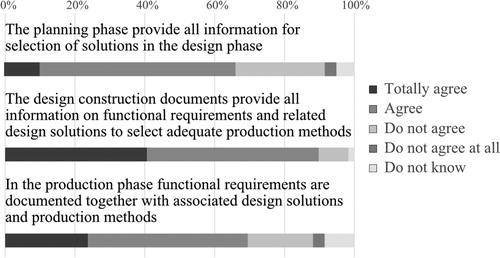
Conceptual model for configuration information
The management of configuration information is a continuous process aimed at ensuring that the description of the product is always updated and accurate (Monticolo et al. Citation2015). Therefore, the information must be available and flow between all stakeholders through the construction phases (Kamara, Anumba, and Evbuomwan Citation2001). presents the proposed conceptual model with the five key areas of configuration information and their interrelationships, based on the ISO 10007:2017 guidelines and the literature review. The following sections present a more detailed description of the results from the literature review and the survey.
Function
The information about required functions is essential for the end-product performance as well as the lifecycle management (ISO Citation2017). The product should be unambiguously defined in the planning or early design phase of construction projects (Chun and Cho Citation2015). Otherwise, the consequences can be low efficiency in the production phase (Minato Citation2003) and insufficient end-product performance (Stasis, Whyte, and Dentten Citation2013). Evaluation of functions in operational use can help clients to develop, refine and standardise their functional requirements (Joseph et al. Citation2014; Ding et al. Citation2019). The functions should be measurable with acceptance criteria (Toor and Ogunlana Citation2010). In the survey, almost all respondents considered information on functions to be present in all construction phases (see ). Most respondents also agreed that the information on functional requirements at the end of the planning phase was sufficient to select design solutions (see ). However, 85% of the respondents considered new requirements common in the design phase, which implies that the information was insufficient. Ensuring that functions have feasible design solutions and construction techniques are essential to prevent unnecessary configuration changes after the planning phase (Bock Citation2015). The respondents ranked structured management of functional requirements as the most important for a high quality of the end-product, followed by documentation of functional requirements (see ). The information about functions is the controlling basis for all other key areas of configuration information and should be available throughout the project process (ISO Citation2017).
Verification
From the design phase to the handover, the fulfilment of the decided functions should be verified to ensure adequate performance of the end-product (Fernandes et al. Citation2015). Verification methods and acceptance values should be established together with the functions in the planning phase to enable a continuous confirmation of the product performance (ISO Citation2017). For example, an acceptance criterion that x number of people should be able to work in the same room for x hours should be converted to measurable values for acquired configurations, such as ventilation, size of the area and sound insulation. Verification methods were documented at the end of the planning phase according to 31% of the respondents. In fact, information on verification methods was not available to any great extent until the end of the production phase (see ). This is consistent with previous observations that verifications in construction projects are performed at the end of projects rather than continuously (Ding et al. Citation2017). Half of the respondents agreed that continuous verification was performed during the production phase. The model in shows that information about verification methods affects all the other key areas, directly or indirectly. Any change of verification methods requires assurance that the decided functions still are measured and that the acceptance values are valid (ISO Citation2017).
Design
The design process is complex since all functions must be included in the product specifications to provide complete information about the configuration (ISO Citation2017). Starting the design before all the functional requirements are established at the end of the planning phase increases the risk of insufficient building performance (Kiviniemi Citation2005). Over half of the respondents considered design solutions were present at the end of the planning phase (see ). To maintain and verify the product performance decided by the client, traceability of the functions in the design specifications are important (Hallerstede, Jastram, and Ladenberger Citation2014). Information on design solutions should be complete at the end of the design phase and include interrelations to functions and production feasibility (ISO Citation2017), as the model in shows. New requirement were considered common in the production phase by 78% of the respondents considered, which implies that the basis for design specifications were incomplete. At the end of the design phase, almost all of the respondents considered that the design information was sufficient to select suitable production methods (see ). The information in the design specifications is important to reduce the risk of insufficient end-product performance (Chen and Luo Citation2014). However, the respondents ranked complete design specifications as the second least important for a high quality of the end-product (see ).
Production
In the model, the production methods refer to techniques required to achieve the configuration on site. During production, the configuration information should provide build status, i.e. account for preservation and delivery of intended functions (ISO Citation2017). Coordination between contractor and designers in the design phase, can enhance the quality of the configuration and ensure feasibility during construction (Porwal and Hewage Citation2013). Half of the respondents considered documentation on production methods to be present at the end of the design phase (see ). If realisation is not feasible, the implications can be unnecessary delays, costs and rework (Parvan, Rahmandad, and Haghani Citation2015). The functional requirement may need modification if there are no design solutions and/or production methods that can realise them. shows that any alteration in the key areas of function, design and production will start a flow of information between them. Most of the respondents considered that the information from these three key areas to be available cohesively (see ).
Change
The initiation of a configuration change starts with a request containing information about the change and the importance of its implementation (Cox et al. Citation1999). Thereafter, a consequence analysis is performed, in which causes and effects are weighed against each other (Ullah et al. Citation2018). Finally, the client makes decisions regarding implementation. Changes that are to be implemented requires updating of configuration information, as well as assurance that the functional requirements of all stakeholders still are fulfilled (ISO Citation2017). Consequently, information about changes needs to be available throughout the construction process (Chun and Cho Citation2015). Fewer respondents considered that documentation of configuration changes was available after the design phase than after the production phase (see ). Changes to the configuration can affect the performance of the end-product (Chun and Cho Citation2015). However, control over configuration changes was considered to have the lowest impact on the quality of the final product by most respondents (see ). As the proposed model shows, the information on configuration changes is interrelated to all other key areas (see ).
Discussion
The results of this study indicate that systematic management of configuration information can apply to construction projects, as described in the proposed model (see ). At the same time, the findings from the literature review and survey show that subject is not frequently applied to construction projects. Real time reliable information about the current configuration can ensure adequate product performance (Stasis, Whyte, and Dentten Citation2013). In the early construction phases, projects often go directly to design solutions instead of first acquiring required functions (Chun and Cho Citation2015), which the results from the survey confirm. Interconnection of information about functions, design solutions and feasible realisation methods can reduce the number of changes and improves efficiency during the production phase (Porwal and Hewage Citation2013). The survey results show that information about production methods was among the least documented. From planning to handover, verification enables to maintain the decided performance of the building (Chun and Cho Citation2015; Fernandes et al. Citation2015). In the survey, only half of the respondents considered continuous verification common in the construction process. Changes in construction projects are often considered inevitable by previous studies (Sun and Meng Citation2009; Shipton, Hughes, and Tutt Citation2014). However, clearly defined product configurations can reduce the number of changes and ensure building performance (Aljohani, Ahiaga-Dagbui, and Moore Citation2017). Unexpectedly, the respondents considered configuration changes to have the least impact on the quality of the end-product.
In complex constructions, such as healthcare facilities (Van Hoof et al. Citation2015), the information about the configuration is especially important (Lindkvist, Stasis, and Whyte Citation2013). The lack of systematic management of configuration information in Swedish healthcare projects can cause problems with insufficient building performance. The survey results are not directly generalisable to other project contexts. However, the conceptual model is generalisable, since the basis is international guidelines and research on configuration information. A shift towards more focus on configuration control in construction projects can ensure development, production and delivery of high performance buildings. Digital building information and automated processes offer new possibilities to manage configuration information systematically (Ding et al. Citation2017). The proposed model shows that configuration information needs to be interrelated and flow between the construction phases (see ). Therefore, any deficiency or insufficient interrelation of information between the key areas of configuration information may impair the building performance.
Conclusions
In the context of construction projects, the findings show deficiencies in configuration information for each key areas of the proposed model. However, most noticeable was the lack of systematic management of the information. The results of this study indicate that the application of configuration information in accordance with the proposed model can solve several issues that construction projects encounter. In addition, to reach the full potential of digital information and automated production techniques, the AEC industry will have to manage configuration information more systematically. The knowledge from this study can serve as a basis for further investigations regarding the application of configuration information in construction projects.
Acknowledgements
The authors are most grateful to Region Stockholm (previous Stockholm County Council) for funding this research. Special thanks to all the participating Swedish Regions for their contributions with resources and time.
Disclosure statement
No potential conflict of interest was reported by the author(s).
Additional information
Funding
Notes on contributors
P. Schönbeck
P. Schönbeck, PhD student, Concrete Structures, Department of Civil and Architectural Engineering, KTH Royal Institute of Technology, Sweden.
M. Löfsjögård
M. Löfsjögård, PhD, Adjunct Professor, Concrete Structures, Department of Civil and Architectural Engineering, KTH Royal Institute of Technology, Sweden.
A. Ansell
A. Ansell, PhD, Professor, Concrete Structures, Department of Civil and Architectural Engineering, KTH Royal Institute of Technology, Sweden.
References
- Aljohani, A., D. Ahiaga-Dagbui, and D. Moore. 2017. “Construction Projects Cost Overrun: What Does the Literature Tell Us?” International Journal of Innovation, Management and Technology 8 (2): 137–143.
- Avci, O., A. Bhargava, Y. Al-Smadi, and J. Isenberg. 2019. “Vibrations Serviceability of a Medical Facility Floor for Sensitive Equipment Replacement: Evaluation with Sparse In Situ Data.” Practice Periodical on Structural Design and Construction 24 (1): 05018006-1–05018006-11. doi:10.1061/(ASCE)SC.1943-5576.0000404.
- Bock, T. 2015. “The Future of Construction Automation: Technological Disruption and the Upcoming Ubiquity of Robotics.” Automation in Construction 59: 113–121. doi:10.1016/j.autcon.2015.07.022.
- CEN. 2016. SS-EN ISO 9000; Quality Management Systems - Fundamentals and Vocabulary. Brussels, Belgium: European Committee for Standardization.
- Chang, L. 1994. “A Psychometric Evaluation of 4-Point and 6-Point Likert-Type Scales in Relation to Reliability and Validity.” Applied Psychological Measurement 18 (3): 205–215. doi:10.1177/014662169401800302.
- Chen, L., and H. Luo. 2014. “A BIM-Based Construction Quality Management Model and its Applications.” Automation in Construction 46: 64–73. doi:10.1016/j.autcon.2014.05.009.
- Chun, J., and J. Cho. 2015. “QFD Model Based on a Suitability Assessment for the Reduction of Design Changes in Unsatisfactory Quality.” Journal of Asian Architecture and Building Engineering 14 (1): 113–120. doi:10.3130/jaabe.14.113.
- Cox, I. D., J. P. Morris, J. H. Rogerson, and G. E. Jared. 1999. “A Quantitative Study of Post Contract Award Design Changes in Construction.” Construction Management and Economics 17 (4): 427–439. doi:10.1080/014461999371358.
- Ding, L., K. Li, Y. Zhou, and P. E. D. Love. 2017. “An IFC-Inspection Process Model for Infrastructure Projects: Enabling Real-Time Quality Monitoring and Control.” Automation in Construction 84: 96–110. doi:10.1016/j.autcon.2017.08.029.
- Ding, Z., S. Liu, L. Liao, and L. Zhang. 2019. “A Digital Construction Framework Integrating Building Information Modeling and Reverse Engineering Technologies for Renovation Projects.” Automation in Construction 102: 45–58. doi:10.1016/j.autcon.2019.02.012.
- Eleftheriadis, S., P. Duffour, and D. Mumovic. 2018. “Participatory Decision-Support Model in the Context of Building Structural Design Embedding BIM with QFD.” Advanced Engineering Informatics 38: 695–711. doi:10.1016/j.aei.2018.10.001.
- Fernandes, J., E. Henriques, A. Silva, and M. A. Moss. 2015. “Requirements Change in Complex Technical Systems: an Empirical Study of Root Causes.” Research in Engineering Design 26 (1): 37–55. doi:10.1007/s00163-014-0183-7.
- Froese, T. M. 2010. “The Impact of Emerging Information Technology on Project Management for Construction.” Automation in Construction 19 (5): 531–538. doi:10.1016/j.autcon.2009.11.004.
- Hallerstede, S., M. Jastram, and L. Ladenberger. 2014. “A Method and Tool for Tracing Requirements Into Specifications.” Science of Computer Programming 82: 2–21. doi:10.1016/j.scico.2013.03.008.
- Hicks, C., T. McGovern, G. Prior, and I. Smith. 2015. “Applying Lean Principles to the Design of Healthcare Facilities.” International Journal of Production Economics 170: 677–686.
- Huovila, P., J. Leinonen, P. Paevere, J. Porkka, and G. Foliente. 2004. “Systematic performance requirements management of built facilities.” Clients Driving International Innovation Conference.
- Idrus, A. B., and J. B. Newman. 2002. “Construction Related Factors Influencing the Choice of Concrete Floor Systems.” Construction Management and Economics 20 (1): 13–19. doi:10.1080/01446190110101218.
- ISO. 2017. ISO 10007; Quality Management - Guidelines for Configuration Management. Geneva, Switzerland: International Organization for Standardization.
- Joseph, A., X. Quan, A. B. Keller, E. Taylor, U. Nanda, and Y. Hua. 2014. “Building a Knowledge Base for Evidence-Based Healthcare Facility Design Through a Post-Occupancy Evaluation Toolkit.” Intelligent Buildings International 6 (3): 155–169. doi:10.1080/17508975.2014.903163.
- Kamara, J. M., C. J. Anumba, and N. F. O. Evbuomwan. 2001. “Assessing the Suitability of Current Briefing Practices in Construction Within a Concurrent Engineering Framework.” International Journal of Project Management 19 (6): 337–351. doi:10.1016/S0263-7863(00)00015-6.
- Kim, T. W., S. H. Cha, and Y. Kim. 2016. “A Framework for Evaluating User Involvement Methods in Architectural, Engineering, and Construction Projects.” Architectural Science Review 59 (2): 136–147. doi:10.1080/00038628.2015.1008397.
- Kiviniemi, A. 2005. “Requirements Management Interface to Building Product Models.” Doctoral thesis, Department of civil and environmental engineering, Stanford university.
- KOLADA. 2019. “Comparison key Perfomance Indicators (only in Swedish), [Jämföraren nyckeltal].” Municipal and County database [Kommun- och landstingsdatabasen]. Accessed January 25. https://www.kolada.se/?_p=index#.
- Lindkvist, C., A. Stasis, and J. Whyte. 2013. “Configuration Management in Complex Engineering Projects.” 2nd International Through-life Engineering Services Conference.
- Luo, X., G. Q. Shen, S. Fan, and X. Xue. 2011. “A Group Decision Support System for Implementing Value Management Methodology in Construction Briefing.” International Journal of Project Management 29 (8): 1003–1017. doi:10.1016/j.ijproman.2010.11.003.
- MathWorks. 2018. “Statistics and Machine Learning Toolbox™ User’s Guide.” Accessed July 26. https://se.mathworks.com/help/pdf_doc/stats/stats.pdf.
- Merschbrock, C., and B.-E. Munkvold. 2015. “Effective Digital Collaboration in the Construction Industry – A Case Study of BIM Deployment in a Hospital Construction Project.” Computers in Industry 73: 1–7. doi:10.1016/j.compind.2015.07.003.
- Minato, T. 2003. “Design Documents Quality in the Japanese Construction Industry: Factors Influencing and Impacts on Construction Process.” International Journal of Project Management 21 (7): 537–546. doi:10.1016/S0263-7863(02)00083-2.
- Monticolo, D., J. Badin, S. Gomes, E. Bonjour, and D. Chamoret. 2015. “A Meta-Model for Knowledge Configuration Management to Support Collaborative Engineering.” Computers in Industry 66: 11–20. doi:10.1016/j.compind.2014.08.001.
- Oesterreich, T. D., and F. Teuteberg. 2016. “Understanding the Implications of Digitisation and Automation in the Context of Industry 4.0: A Triangulation Approach and Elements of a Research Agenda for the Construction Industry.” Computers in Industry 83: 121–139. doi:10.1016/j.compind.2016.09.006.
- Pärn, E. A., D. J. Edwards, and M. C. P. Sing. 2017. “The Building Information Modelling Trajectory in Facilities Management: A Review.” Automation in Construction 75 (C): 45–55. doi:10.1016/j.autcon.2016.12.003.
- Parvan, K., H. Rahmandad, and A. Haghani. 2015. “Inter-phase Feedbacks in Construction Projects.” Journal of Operations Management 39–40 (C): 48–62. doi:10.1016/j.jom.2015.07.005.
- Porwal, A., and K. N. Hewage. 2013. “Building Information Modeling (BIM) Partnering Framework for Public Construction Projects.” Automation in Construction 31: 204–214. doi:10.1016/j.autcon.2012.12.004.
- Shen, W., Q. Hao, H. Mak, J. Neelamkavil, H. Xie, J. Dickinson, R. Thomas, A. Pardasani, and H. Xue. 2010. “Systems Integration and Collaboration in Architecture, Engineering, Construction, and Facilities Management: A Review.” Advanced Engineering Informatics 24 (2): 196–207. doi:10.1016/j.aei.2009.09.001.
- Shipton, C., W. Hughes, and D. Tutt. 2014. “Change Management in Practice: An Ethnographic Study of Changes to Contract Requirements on a Hospital Project.” Construction Management and Economics 32 (7–8): 787–803. doi:10.1080/01446193.2014.915336.
- Smith, P. 2014. “BIM Implementation – Global Strategies.” Procedia Engineering 85: 482–492. doi:10.1016/j.proeng.2014.10.575.
- Stasis, A., J. Whyte, and R. Dentten. 2013. “A Critical Examination of Change Control Processes.” Procedia CIRP 11: 177–182. doi:10.1016/j.procir.2013.07.053.
- Sun, M., and X. Meng. 2009. “Taxonomy for Change Causes and Effects in Construction Projects.” International Journal of Project Management 27 (6): 560–572. doi:10.1016/j.ijproman.2008.10.005.
- Toor, S-ur-R., and S. O. Ogunlana. 2010. “Beyond the ‘Iron Triangle’: Stakeholder Perception of Key Performance Indicators (KPIs) for Large-Scale Public Sector Development Projects.” International Journal of Project Management 28 (3): 228–236. doi:10.1016/j.ijproman.2009.05.005.
- Ullah, I., D. Tang, Q. Wang, L. Yin, and I. Hussain. 2018. “Managing Engineering Change Requirements During the Product Development Process.” Concurrent Engineering: Research and Applications 26 (2): 171–186. doi:10.1177/1063293X17735359.
- UNEP. 2018. Global Status Report, Towards a Zero-Emission, Efficient and Resilient Buildings and Construction Sector. United Nations Environment Programme.
- Van Hoof, J., P. G. S. Rutten, C. Struck, E. R. C. M. Huisman, and H. S. M. Kort. 2015. “The Integrated and Evidence- Based Design of Healthcare Environments.” Architectural Engineering and Design Management 11 (4): 243–263. doi:10.1080/17452007.2014.892471.
- Whyte, J., A. Stasis, and C. Lindkvist. 2016. “Managing Change in the Delivery of Complex Projects: Configuration Management, Asset Information and ‘big Data’.” International Journal of Project Management 34 (2): 339–351. doi:10.1016/j.ijproman.2015.02.006.
- Zhang, L. L. 2014. “Product Configuration: A Review of the State-of-the-Art and Future Research.” International Journal of Production Research 52 (21): 1–18. doi:10.1080/00207543.2014.942012.

